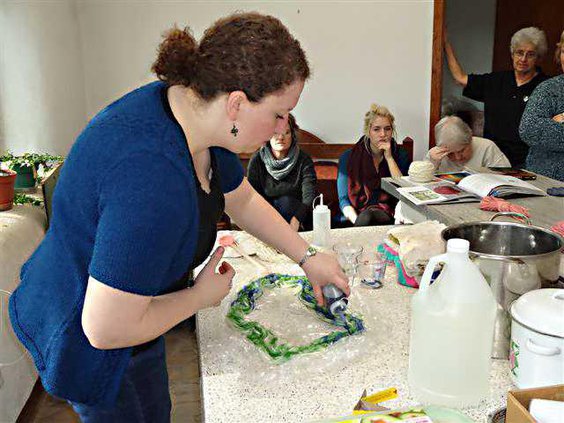Great Bend’s Jean Aycock is a nature educator at Kansas Wetlands Education Center. A fascination with nature led her to her career as a nature educator. In a roundabout way, it also led her to her passion, fiber arts.
In 2012, she was learning to spin wool, and was intrigued with how a friend had achieved a beautiful brown color from pecan husks. Later, a workshop she led to inform visitors to KWEC about how plants have been used throughout human history to dye cloth further piqued her interest. She’s been adding to her knowledge ever since.
“I’m fascinated with dying because it helps me to feel a connection with people from the past,” she said. “It connects us with the past and the world around us.”
In January, Heartland Farm invited her to share dyeing techniques at Fiber Space, an annual workshop where attendees learn the basics and more of spinning, weaving, knitting and crocheting. She was happy to accept the opportunity to give back to the sisters who have taught her much about her craft.
Most natural dyes come in shades of browns or yellows, she has learned. Oranges and reds are more rare, followed by greens and blue in order of difficulty. Most fascinating is achieving purple naturally, she said.
“Tyrian purple, in ancient times, could only be used for royal garments, because the compounds were so rare to come by,” she said. “Thousands of snails were collected and crushed to produce just a small amount of the dye. It was very labor intensive. Getting good strong colors was an effort. Today, it’s much different.”
One of her favorite dyes comes from a common wildflower, the coreopsis. The flowers can be added to water to make a tea of sorts. Then, when wool fiber or yarn is added, the pigments from the flowers transfer and a vibrant orange is the result.
“There are a variety of techniques, all acquired through trial and error,” she said. “People have been figuring it out since ancient times.”
Fiber that comes from animals is the easiest to dye, she says. Mixing barks, leaves, or petals with a simple mordant - a chemical used to translate between the wool and the dye, like vinegar - and time are all that are required.
Plant fibers like cotton or linen require more complicated steps. At the workshop, she shared techniques that included the use of not-so-natural dyes made from unsweetened Kool-Aid and food coloring. Gradient colors were achieved through total immersion in a crockpot dye bath, called kettle dyeing. The color on the outside of the ball of yarn takes up the most dye, and is most vibrant, and it becomes lighter closer to the center. Variegated yarns were created through the technique called hand painting.
Aycock filled plastic bottles with dye solution and squirted the dye over a span of natural alpaca yarn. After setting, the yarn is rinsed and dried. The finished colors are hard to predict, she says. While she started out hoping for a combination of green and blue, the finished yarn was green and a pinkish-lavender color. Every attempt produces a completely unique yarn, however, which helps to make experimenting fun.
Her favorite fiber to use, she admits, is alpaca from Heartland Farm.
“It’s soft, beautiful, and I can say hello to the animal who produce it,” she said. “I’m a sucker for knowing the critters and knowing the people who raised them.”
Fiber Space 2 is coming up on Feb. 19-20. Aycock will return, helping to teach beginning spinning techniques and possible another dye demonstration. Weaving, knitting and crocheting will also be taught. For more information, visit the Heartland Farm website at http://www.heartlandfarm-ks.org/
Hobby worth dyeing for
Fiber Space helping beginning artists put color into craft





